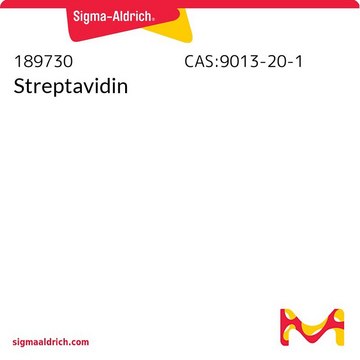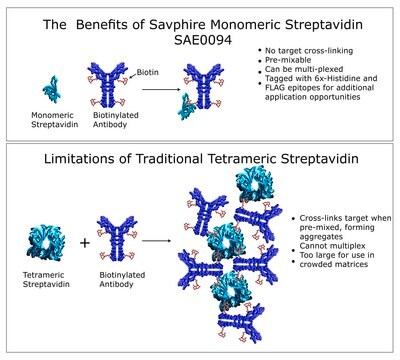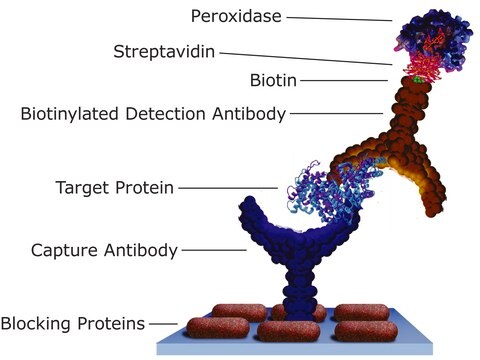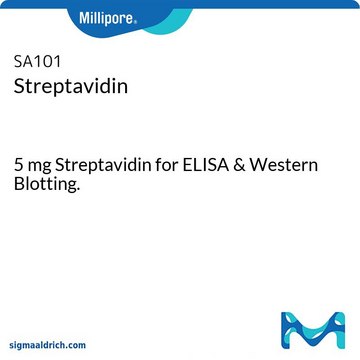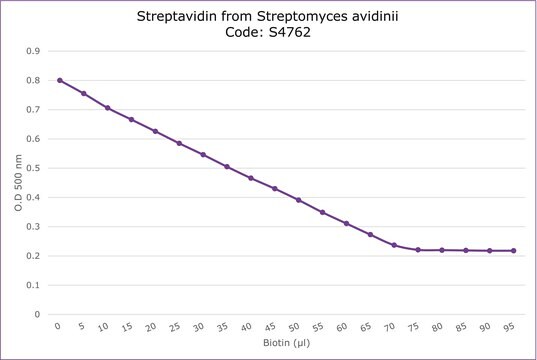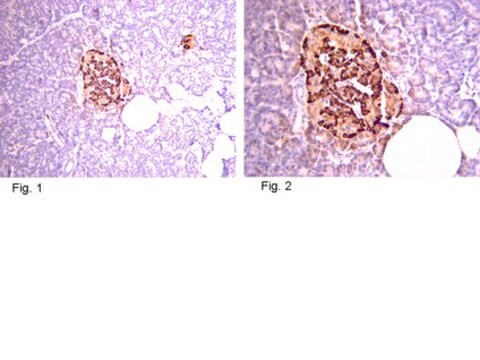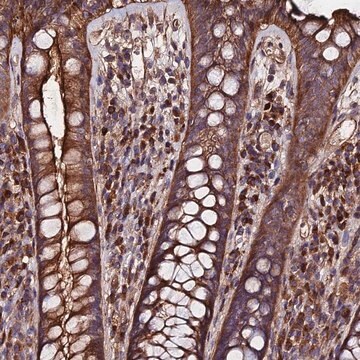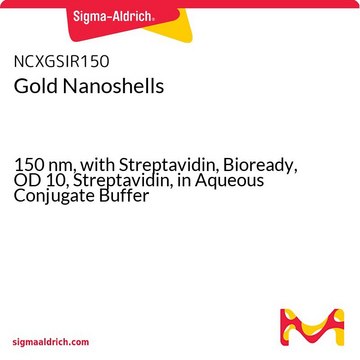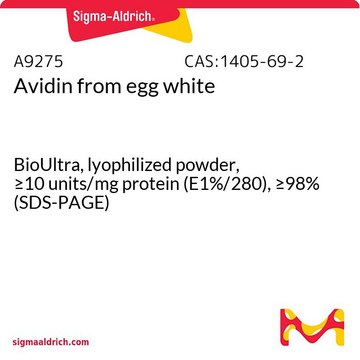Wszystkie zdjęcia(1)
Kluczowe dokumenty
RSTREP-RO
Roche
Streptavidin, recombinant
liquid, ≥17 units/mg protein, pH range 5.0-9.0
Synonim(y):
streptavidin
Zaloguj sięWyświetlanie cen organizacyjnych i kontraktowych
About This Item
Kod UNSPSC:
12352202
Polecane produkty
pochodzenie biologiczne
Streptomyces sp. ( Streptomyces avidinii)
Poziom jakości
rekombinowane
expressed in E. coli
Formularz
liquid
aktywność właściwa
≥17 units/mg protein
masa cząsteczkowa
~52 kDa
opakowanie
pkg of 1 mg (11721666001)
pkg of 5 mg (11721674001)
producent / nazwa handlowa
Roche
stężenie
70-90%
metody
protein array: suitable
protein purification: suitable
zanieczyszczenia
6-7% water
zakres pH
5.0-9.0
pI
7.4-7.7 (two main bands)
rozpuszczalność
water: 10 mg/L (mA405=100)
przydatność
suitable for immunological tests
numer dostępu UniProt
Warunki transportu
cooler
temp. przechowywania
-10 to -25°C
Powiązane kategorie
Opis ogólny
Streptavidin, a highly versatile protein, is naturally produced by Streptomyces avidinii. It exhibits a strong affinity for biotin, forming a non-covalent yet robust binding interaction. This unique property makes streptavidin an ideal choice for various biological detection systems, including western blotting, enzyme-linked immunosorbent assays (ELISA), and immunohistochemistry.
Zastosowanie
Use Streptavidin, recombinant for coating of solid phases (e.g., microplates, beads etc.) as well with biotin-labeled haptens and antibodies in universal immunological detection systems (streptavidin/biotin system).
Sekwencja
Streptavidin is a tetramer with a molecular weight of approximately 53 kD consisting of four subunits of approximately 13 kD, each containing a single biotin-binding site.
Each subunit has six tyrosine residues.The protein is free of carbohydrate.
Each subunit has six tyrosine residues.The protein is free of carbohydrate.
Definicja jednostki
One unit binds 1 μg D-biotin at pH 8.9.
Postać fizyczna
White lyophilizate; lyophilized in a 20 mM potassium phosphate, pH 6.5 solution
Protein: 0.7 ± 0.1mg protein lyophilizate (A282 = 3.1)
KD: 10-15M
Protein: 0.7 ± 0.1mg protein lyophilizate (A282 = 3.1)
KD: 10-15M
Inne uwagi
For life science research only. Not for use in diagnostic procedures.
Ta strona może zawierać tekst przetłumaczony maszynowo.
Kod klasy składowania
11 - Combustible Solids
Klasa zagrożenia wodnego (WGK)
WGK 1
Temperatura zapłonu (°F)
does not flash
Temperatura zapłonu (°C)
does not flash
Wybierz jedną z najnowszych wersji:
Masz już ten produkt?
Dokumenty związane z niedawno zakupionymi produktami zostały zamieszczone w Bibliotece dokumentów.
Klienci oglądali również te produkty
Automated combinatorial process for nanofabrication of structures using bioderivatized nanoparticles.
Dehlinger D, et al.
Journal of the Association for Laboratory Automation, 5, 267-276 (2007)
John E G McCarthy et al.
Methods in enzymology, 430, 247-264 (2007-10-05)
A growing number of biophysical techniques use immobilized reactants for the quantitative study of macromolecular reactions. Examples of such approaches include surface plasmon resonance, atomic force microscopy, total reflection fluorescence microscopy, and others. Some of these methods have already been
THE PROPERTIES OF STREPTAVIDIN, A BIOTIN-BINDING PROTEIN PRODUCED BY STREPTOMYCETES.
L CHAIET et al.
Archives of biochemistry and biophysics, 106, 1-5 (1964-07-20)
Global Trade Item Number
| SKU | GTIN |
|---|---|
| 11721666001 | 4061838704955 |
| 11721674001 | 4061838704962 |
Nasz zespół naukowców ma doświadczenie we wszystkich obszarach badań, w tym w naukach przyrodniczych, materiałoznawstwie, syntezie chemicznej, chromatografii, analityce i wielu innych dziedzinach.
Skontaktuj się z zespołem ds. pomocy technicznej